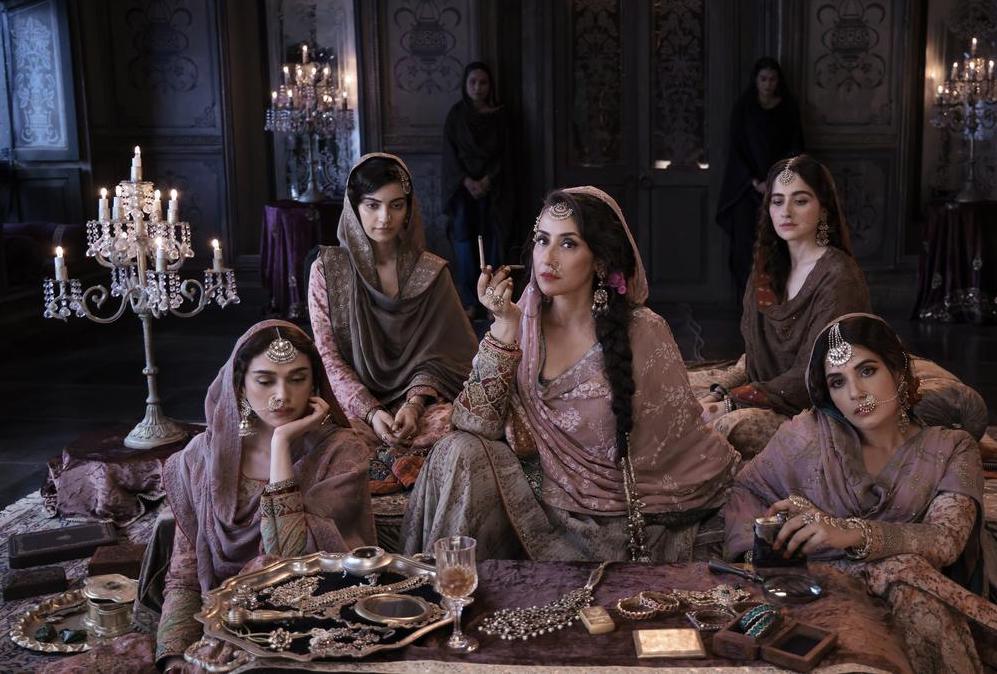Heeramandi: The Diamond Bazaar, the show created and directed by Sanjay Leela Bhansali for Netflix, aims to be a grand and majestic ode to the red-light area of Lahore in pre-Independence India. Sadly though, for all the gloss and glitter, it has little going for it and makes for rather tedious viewing.
The web series follows Mallikajaan (Manisha Koirala), a devious albeit graceful courtesan, her younger sister Waheedajaan (Sanjeeda Sheikh) and daughters Bibbojaan (Aditi Rao Hydari), Lajjo (Richa Chadha) and Alamzeb (Sharmin Sehgal), who hail from an in-demand kotha which receives patronage from the nobility. All seems to be going well until her niece Fareedan (Sonakshi Sinha) returns to seek vengeance for her mother’s death. What follows is a tale of greed, power and betrayal as each of them manoeuvres through the politics of Heeramandi amidst rising tensions in the city to gain independence from the British Raj.
When one thinks of the words larger-than-life, grandeur, colour, song and dance in the context of contemporary Indian cinema, the name Sanjay Leela Bhansali is the first that comes to mind. With Heeramandi, Bhansali lives up to his reputation of creating huge, heavy-duty set pieces to enchant his viewers, realism be damned. It is impossible to deny that each frame in Heeramandi feels like a beautiful company era painting that one often finds in art galleries or museums. The main issue with Heeramandi, however, is that its royal costumes and awe-inspiring sets aside, it has nothing much going for it. There is a conspicuous dearth of nuance be it be in the overall plot that lacks depth, intra-character dynamics and even character arcs. What had the potential and opportunity to deeply explore human psyches and the fragility of human relations combined with elements of historic significance is shockingly brushed aside in favour of its tepid grandeur.
That said, it is also interesting to note how Bhansali sheds light on the contrast between the patriarchy present in society at large in the 1920s, but the matriarchal construct of the bordellos. Not only do the women of Heeramandi run well structured, complex and effective organisations that follow a set of rules whilst playing cheap politics amongst themselves to gain power, they also have a strong sway over their elite clients hence controlling far more than they seem to be.
Amongst the characters, Mallikajaan, the matriarch of the Shahi Mahal, places her twisted principles above all else (including family) ensuring that her autocratic rule over Shahi Mahal and Heeramandi remains. Both her daughters, surprisingly, are polar opposites of their mother. Due to learnings over time, they become strong individuals who ensure their tact and wit is used for noble causes. Bibbojaan uses her position to gain secrets from her clients, Nawab Wali Muhammed (Fardeen Khan) and later the British Inspector Henderson himself, which she supplies to the rebels. It is her character whose arc is the most fleshed out. She also provides moral support to her younger sister Alamzeb, who rebels against being a courtesan, aspiring instead to be a poet. A chance encounter of her with Tajdar (Taha Shah), a Nawab, sparks a forbidden romance. With Alamzeb, the makers had ample opportunity to create a character that had several layers, complexity and internal contradictions, which sadly fails to be the case. It is disheartening to see her character receive ample screen time just for replying coyly to Tajdar’s attempts to woo her or yearning for him in a romance, which feels highly contrived.
Alamzeb and Tajdar’s love story is encouraged, albeit for ill reasons, by Mallikajaan’s niece and arch nemesis Fareedan, who comes to Heeramandi with the sole intention of usurping the throne from Mallikajaan. The rivalry they share and their Machiavellian scheming against each other is intriguing, since both are in fact two sides to the same coin. Sadly though, Faredeen is finally defeated with the makers giving her a forced and cringeworthy resolution at the end. If one has to give Bhansali some credit, he does ensure that all the courtesans contain some shades of grey in their personality thereby making it incredibly tough to side with anyone in particular.
Over the top performances and careless writing (especially during the climax) proves to be a major antithesis to the thorough production design and masterful cinematography in Heeramandi. Yet, one cannot escape the feeling one gets throughout the series that the lavish palaces and busy marketplaces are all part of one big film/studio set. The series finale feels oh-so-labored, with each arc and subplot being rushed to some sort of resolution and a coerced intertwining of the ‘courtesan plot’ to the ‘fight for Independence plot’. The rhythm and pace of the overall series is distressingly slow, with very little unfolding in the majority of the scenes. Every episode, although an hour long, feels far longer. The VFX is concerningly and glaringly apparent even on a television screen, testing the viewer’s suspension of disbelief. The sound design is intricate if not as immersive as one would hope. Thankfully, the background score is judiciously and effectively employed. The best part of Heeramandi however, are its songs. Bhansali’s compositions have an invigorating effect that probably is the most melodious of his recent filmography.
All in all, Heeramandi is strong evidence of work that is so vehemently style over substance, that in spite of some dazzling imagery, it leaves one highly underwhelmed. And that is its biggest shortcoming.
Hindi, Urdu, Drama, Color


